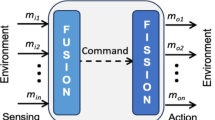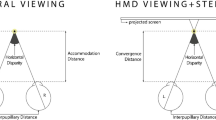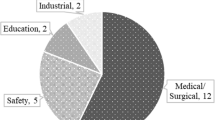Abstract
The use of composite multiple feedback in a newly proposed virtual reality system enables the patient to perceive similar real-world performance in the virtual world. However, it might cause information overload, which makes the patient feel confused and distracted during training. The aim of this study is to investigate the effectiveness of having separate function-specific feedback pre-training prior to the final multiform feedback task. During the evaluating tests with thirty healthy subjects, it has been found that effective pre-training set could overcome the problem in the main task. Minor modifications on the pre-training set could overcome or aggravate the problem, which indicates the importance of choosing the correct pre-training parameters.











Similar content being viewed by others
References
Polhemus Corp. (2005) 3space FASTRAK user’s manual. In: OPM00PI002, Rev.E, April 2005
Adamovich SV, Merians AS, Boian R, Lewis JA, Tremaine M, Burdea GS, Recce M, Poizner H (2005) A virtual reality-based exercise system for hand rehabilitation post-stroke. Presence 14(2):161–174
Binder SA, Moll CB, Wolf SL (1981) Evaluation of electromyographic biofeedback as an adjunct to therapeutic exercise in treating the lower extremities of hemiplegic patients. Phys Therapy 61:886–893
Broeren J, Bjorkdahl A, Claesson L, Goude D, Lundgeren-Nilsson A, Samuelsson H, Blomstrand C, Sunnerhagen KS, Rydmark M (2008) Virtual rehabilitation after stroke. In: Andersen SK et al (eds) eHealth beyond the horizon. IOS Press, Amsterdam, pp 77–82
Burdea GC, Coiffet P (2003) Virtual reality technology, 2nd edn. Wiley, New Jersey
Chen YP, Huang H, Xu WW, Wallis RI, Sundaram H, Rikakis T, Ingalls T, Olson L, He JP (2006) The design of a real-time, multimodal biofeedback system for stroke patient rehabilitation. In: MM’06, Santa Barbara, California, USA
Crosbie JH, Lennon S, McGoldrick MC, McNeill MDJ, Burke JW, McDonough SM (2008) Virtual reality in the rehabilitation of the upper limb after hemiplegic stroke: a randomised pilot study. In: Proceedings of 7th ICDVRAT with ArtAbilitation, Maia, Portugal, pp 229–235
De Luca CJ (2002) Fundamental Concepts in EMG Signal Acquisition. Delsys Incorporated. http://www.delsys.com/Attachments_pdf/WP_Sampling1-4.pdf
Dursun E, Dursun N, Alican D (2004) Effects of biofeedback treatment on gait in children with cerebral palsy. Disabil Rehabil 26(2):116–120
Fridlund AJ, Cacioppo JT (1986a) Guidelines for human electromyographic research. Psychophysiology 23(5):567–589
Fridlund AJ, Cacioppo JT (1986b) Guidelines for human electromyographic research. Psychophysiology 23(5):567–589
Hampton RE (1994) Introductory biological statistics. W. C. Brown Publishers, Dubuque, IA
Holden MK, Dyar T (2002) Virtual environment training: a new tool for neurorehabilitation. Neurol Rep 26:62–71
XNA creators club online, http://creators.xna.com/en-GB/, 31/10/2009
Huang H, Wolf SL, He JP (2006) Recent developments in biofeedback for neuromotor rehabilitation: review. J Neuroeng Rehabil 3:11
Koritnik T, Bajd T, Munih M (2008) Virtual environment for lower-extremities training. Gait Posture 27:323–330
Ma S, Varley MR, Richards J, Shark L (2009) Overcoming the information overload problem in a multiform feedback based virtual reality system for hand motion rehabilitation. In: International conference on CyberWorlds, cw, pp 51–56
Norman GR, Streiner DL (2000) Biostatistics: the bare essentials, 2nd edn. B.C. Decker, Hamilton
Richards J (2008) Biomechanics in clinic and research: an online interactive teaching and learning course. Churchill Livingstone, Edinburgh
Stewart JC, Yeh SC, Jung Y, Yoon H, Whitford M, Chen SY, Li L, McLaughlin M, Rizzo A, Winstein CJ (2007) Intervention to enhance skilled arm and hand movements after stroke: a feasibility study using a new virtual reality system. J Neuroeng Rehabil 4:21
Subramanian S, Knaut LA, Beaudoin C, McFadyen BJ, Feldman AG, Levin MF (2007) Virtual reality environment for post-stroke arm rehabilitation. J Neuroeng Rehabil 4:20
Sveistrup H (2004) Motor rehabilitation using virtual reality: review. J Neuroeng Rehabil 1:10
Viau A, Feldman AG, McFadyen BJ, Levin MF (2004) Reaching in reality and virtual reality: a comparison of movement kinematics in healthy subjects and in adults with hemiparesis. J Neuroeng Rehabil 1:11
Wolf SL (1983) Electromyographic biofeedback applications to stroke patients: a critical review. Phys Therapy 63:1448–1459
Zardoshti-Kermani M, Wheeler BC, Badie K, Hashemi RM (1995) EMG feature evaluation for movement control of upper extremity prostheses. IEEE Trans Rehabil Eng 3(4):324–333
Author information
Authors and Affiliations
Corresponding author
Rights and permissions
About this article
Cite this article
Ma, S., Varley, M., Shark, LK. et al. Overcoming the information overload problem in a multiform feedback-based virtual reality system for hand motion rehabilitation: healthy subject case study. Virtual Reality 16, 325–334 (2012). https://doi.org/10.1007/s10055-012-0209-2
Received:
Accepted:
Published:
Issue Date:
DOI: https://doi.org/10.1007/s10055-012-0209-2




